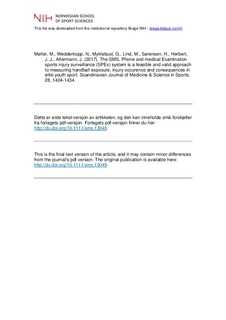| dc.contributor.author | Møller, Merete | |
| dc.contributor.author | Wedderkopp, Niels | |
| dc.contributor.author | Myklebust, Grethe | |
| dc.contributor.author | Lind, Martin | |
| dc.contributor.author | Sørensen, Henrik | |
| dc.contributor.author | Hebert, Jeffrey J. | |
| dc.contributor.author | Attermann, Jørn | |
| dc.date.accessioned | 2019-04-04T11:27:12Z | |
| dc.date.available | 2019-04-04T11:27:12Z | |
| dc.date.created | 2018-01-11T13:02:51Z | |
| dc.date.issued | 2017 | |
| dc.identifier.citation | Scandinavian Journal of Medicine & Science in Sports. 2017, 28, 1424-1434. | nb_NO |
| dc.identifier.issn | 0905-7188 | |
| dc.identifier.uri | http://hdl.handle.net/11250/2593313 | |
| dc.description | I Brage finner du siste tekst-versjon av artikkelen, og den kan inneholde ubetydelige forskjeller fra forlagets pdf-versjon. Forlagets pdf-versjon finner du på onlinelibrary.wiley.com / In Brage you'll find the final text version of the article, and it may contain insignificant differences from the journal's pdf version. The definitive version is available at onlinelibrary.wiley.com | nb_NO |
| dc.description.abstract | Current methods of sports injury surveillance are limited by lack of medical validation of self-reported injuries, and/or incomplete information about injury consequences beyond time-loss from sport. The aims of this study were to 1) evaluate the feasibility of the SMS, Phone and medical Examination injury surveillance (SPEx) system 2) to evaluate the proportion of injuries and injury consequences reported by SPEx when compared to outcomes from a modified version of the Oslo Sports Trauma Research Centre (OSTRC) Overuse Injury Questionnaire. We followed 679 elite adolescent handball players over 31 weeks using the SPEx system. During the last 7 weeks, we also implemented a modified OSTRC questionnaire in a subgroup of 271 players via telephone interviews. The weekly response proportions to the primary SPEx questions ranged from 85% to 96% (mean 92%). SMS responses were received from 79% of the participants within 1 day. 95% of reported injuries were classified through the telephone interview within a week, and 67% were diagnosed by medical personnel. Comparisons between reported injuries from SPEx and OSTRC demonstrated fair [κ=39.5% (25.1% to 54.0%)] to substantial [PABAK=66.8% (95% CI 58.0% to 75.6%)] agreement. The average injury severity score difference between SPEx and the OSTRC approach was -0.2 (95% CI -3.69 to 3.29) out of possible 100 with 95% limits of agreement from (-14.81 to 14.41). These results support the feasibility and validity of the SPEx injury surveillance system in elite youth sport. Future studies should evaluate the external validity of SPEx system in different cohorts of athletes. | nb_NO |
| dc.language.iso | eng | nb_NO |
| dc.subject | athletic injury | nb_NO |
| dc.subject | handball | nb_NO |
| dc.subject | injury registration | nb_NO |
| dc.subject | surveillance | nb_NO |
| dc.subject | validation study | nb_NO |
| dc.title | The SMS, Phone and medical Examination sports injury surveillance (SPEx) system is a feasible and valid approach to measuring handball exposure, injury occurrence and consequences in elite youth sport | nb_NO |
| dc.title.alternative | The SMS, Phone and medical Examination sports injury surveillance (SPEx) system is a feasible and valid approach to measuring handball exposure, injury occurrence and consequences in elite youth sport | nb_NO |
| dc.type | Journal article | nb_NO |
| dc.type | Peer reviewed | nb_NO |
| dc.description.version | acceptedVersion | nb_NO |
| dc.source.pagenumber | 1424-1434 | nb_NO |
| dc.source.volume | 28 | nb_NO |
| dc.source.journal | Scandinavian Journal of Medicine & Science in Sports | nb_NO |
| dc.source.issue | 4 | nb_NO |
| dc.identifier.doi | 10.1111/sms.13049 | |
| dc.identifier.cristin | 1540768 | |
| dc.description.localcode | Seksjon for idrettsmedisinske fag / Department of Sports Medicine | nb_NO |
| cristin.unitcode | 150,34,0,0 | |
| cristin.unitname | Seksjon for idrettsmedisinske fag | |
| cristin.ispublished | true | |
| cristin.fulltext | postprint | |
| cristin.qualitycode | 2 | |
